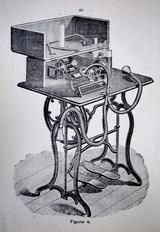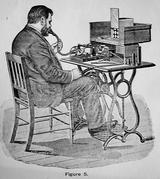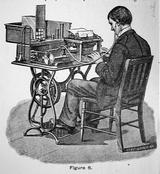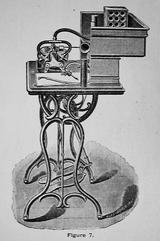 "Machines of the design shown in Figure 4 have been in operation in Washington for at lease eighteen months, and they have also been exhibited successfully in other places in differenct parts of the country. Instead of a single speaking-tube and mouth-piece,a double arrangement is used when it is desired to record a conversation between two persons. This is found very convenient for taking depostions and in similar work." "Machines of the design shown in Figure 4 have been in operation in Washington for at lease eighteen months, and they have also been exhibited successfully in other places in differenct parts of the country. Instead of a single speaking-tube and mouth-piece,a double arrangement is used when it is desired to record a conversation between two persons. This is found very convenient for taking depostions and in similar work."
Fig. 4 in Electrical World 1888/07/14
from Tainter Papers, NMAH |  "In the spring of 1887 I designed the form of graphophone shown in Figures 5 and 6. This machine is the one in practical use at the present time, and being manufactured for sale by the American Graphophone Co. " Tainter is pictured as the operator. "In the spring of 1887 I designed the form of graphophone shown in Figures 5 and 6. This machine is the one in practical use at the present time, and being manufactured for sale by the American Graphophone Co. " Tainter is pictured as the operator.
Fig. 5 in Electrical World 1888/07/14
from Tainter Papers, NMAH |  "Figure 6 shows the machine arranged for reproducing the records and making a type-writer copy. By pressing one of the small keys shown on the right of the graphophone, the reporduction of what is recorded on the wax cylinder commences, and a slight pressure on the second key stops the cylinder while the motions of the foot and regulator continue." Percival Waters is pictured as the operator. "Figure 6 shows the machine arranged for reproducing the records and making a type-writer copy. By pressing one of the small keys shown on the right of the graphophone, the reporduction of what is recorded on the wax cylinder commences, and a slight pressure on the second key stops the cylinder while the motions of the foot and regulator continue." Percival Waters is pictured as the operator.
Fig. 6 in Electrical World 1888/07/14
from Tainter Papers, NMAH |  "The graphophone can be converted from a single to a double machine. Each cylinder has a separate recorder, the two recorders being connected to one speaking-tube, and two records are made at the same time." "The graphophone can be converted from a single to a double machine. Each cylinder has a separate recorder, the two recorders being connected to one speaking-tube, and two records are made at the same time."
Fig. 7 in Electrical World 1888/07/14
from Tainter Papers, NMAH |